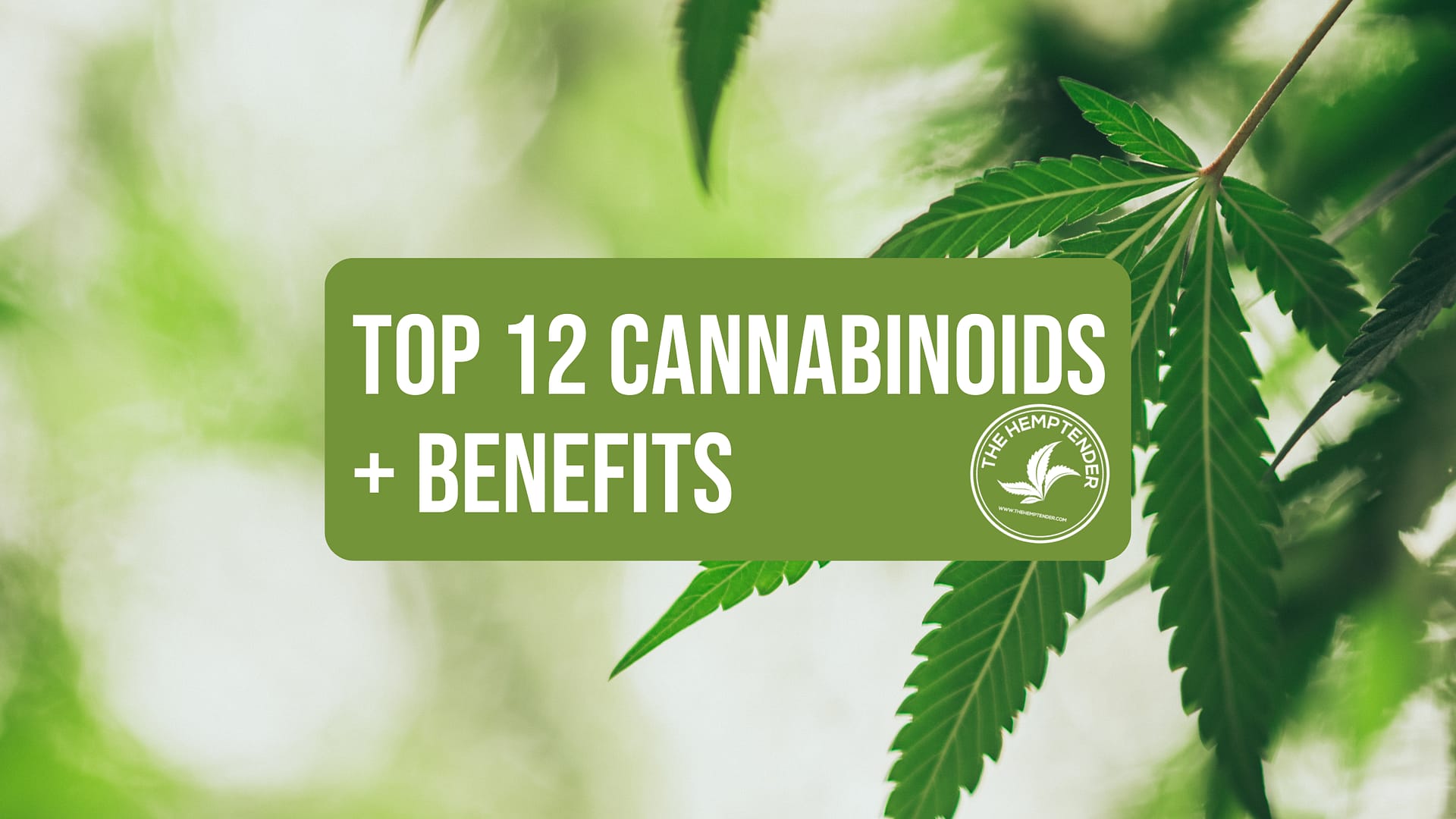The Top 12 Cannabinoids and Their Potential Benefits

A cannabinoid is a chemical compound naturally present in the cannabis plant. These compounds interact with the body’s endocannabinoid system, which plays a crucial role in regulating various physiological processes such as sleep, inflammation, mood, and appetite.
Cannabis contains over 100 different cannabinoids, each capable of producing a diverse range of effects. Among the most well-known cannabinoids is tetrahydrocannabinol (THC), responsible for the psychoactive effects commonly associated with cannabis use. Another prominent cannabinoid is cannabidiol (CBD), which lacks psychoactive properties and is believed to offer numerous potential therapeutic benefits.
Research into cannabinoids’ therapeutic potential is ongoing, with some studies indicating possible anti-inflammatory and pain-relieving properties. However, a comprehensive understanding of their therapeutic applications requires a little more research.
But that brings us to our next point. Below is a list of the top 12 cannabinoids found in cannabis, accompanied by brief descriptions for each. You can use this information as a pocket guide along your wellness journey.
1. THC
Delta- 9 Tetrahydrocannabinol (THC) is the primary psychoactive compound in cannabis, producing the characteristic “high” when consumed. It interacts with the endocannabinoid system, primarily binding to CB1 receptors in the brain and nervous system, affecting mood, perception, and cognition.
THC’s potential benefits include pain relief, anti-nausea effects, and appetite stimulation. Additionally, there are indications of its potential neuroprotective properties for certain neurological disorders. However, THC can also cause adverse effects, including anxiety, paranoia, impaired memory, coordination issues, and increased heart rate.
Long-term, heavy use may lead to psychological dependence and memory-related problems. Responsible use and awareness of potential side effects are crucial, and consulting with a healthcare professional before using THC or cannabis products is advised, especially for those with medical conditions or taking other medications.
2. THC-A
Tetrahydrocannabinolic acid (THC-a) is a non-psychoactive compound found in raw cannabis. It only converts to psychoactive THC when exposed to heat. THC-a is believed to offer potential therapeutic benefits, such as anti-inflammatory and neuroprotective properties, making it appealing for potentially managing chronic pain and nausea.
Unlike THC, THC-a does not produce a “high” unless it’s heated through smoking or vaping, making it an attractive option for medicinal use without mind-altering effects. However, research on THC-a is still limited compared to THC and CBD, and responsible use is essential. As our understanding of cannabis compounds advances, we may gain a clearer picture of THC-a’s benefits and effects.
3. THC-V
Tetrahydrocannabivarin (THC-V) is a lesser-known psychoactive cannabinoid found in cannabis. It interacts with CB1 and CB2 receptors in the endocannabinoid system, but its precise mechanism of action remains unclear.
THC-V’s potential benefits include appetite suppression and neuroprotective properties. It has also demonstrated possible anxiety-reducing effects and may promote bone growth, though more research is needed to fully understand its therapeutic potential and potential side effects.
4. CBD
Cannabidiol (CBD) is a non-intoxicating compound found in cannabis, known for its potential therapeutic benefits. While it won’t cause you to feel high, it interacts with the endocannabinoid system, influencing various receptors, and has been associated with potential anti-inflammatory, pain-relieving, and anxiolytic effects.
While generally considered safe, CBD can cause side effects such as drowsiness, dry mouth, and changes in appetite. It’s essential to consult with a healthcare professional before using CBD, especially if taking other medications. Responsible use and ongoing research are crucial to unlocking its full potential as a natural remedy.
5. CBG
Cannabigerol (CBG) is a non-psychoactive cannabinoid found in cannabis, acting as a precursor to THC and CBD. Also known as the Mother Cannabinoid, it interacts with CB1 and CB2 receptors in the endocannabinoid system, showing potential anti-inflammatory and neuroprotective effects.
CBG may hold promise in managing certain inflammatory symptoms. Preliminary studies suggest it might inhibit the growth of certain cancer cells. While generally considered safe and non-intoxicating, more research is needed to understand CBG’s long-term effects and interactions with medications.
6. CBG-A
Cannabigerolic acid (CBG-a) is a non-psychoactive cannabinoid found in raw cannabis, acting as a precursor to CBG and other major cannabinoids. While its specific mechanisms of action are not fully understood, CBG-a interacts with the endocannabinoid system, potentially influencing CB1 and CB2 receptors.
Limited research on CBG-a suggests potential benefits, including anti-inflammatory properties, and neuroprotective effects. Additionally, CBG-a has been explored for its potential in inhibiting the growth of certain cancer cells. However, due to its relative lack of research, potential side effects and individual responses require further investigation.
7. CBN
Cannabinol (CBN) is a minor non-psychoactive cannabinoid found in aged cannabis flowers. Its interaction with the endocannabinoid system remains partially understood, but it is believed to have a weak affinity for CB1 and CB2 receptors. CBN shows potential in promoting sleep and managing insomnia due to its potential sedative properties. However, recent studies have challenged this scientific opinion.
CBN may also possess anti-inflammatory qualities and is thought to have some pain-relieving effects. While CBN is generally considered safe and non-intoxicating, more research is needed to fully understand its potential benefits and side effects.
8. CBC
Cannabichromene (CBC) is a non-psychoactive cannabinoid found in cannabis, interacting with the endocannabinoid system, though its mechanisms are not fully understood. It shows potential benefits in managing inflammation and pain due to its anti-inflammatory properties. CBC may also promote neurogenesis, which could be beneficial for brain health and neurological disorders. Additionally, it has been studied for potential antidepressant effects, influencing mood-regulating neurotransmitter systems. While generally considered safe and non-intoxicating, more research is needed to fully understand CBC’s effects and potential side effects.
9. Delta-8 THC
Delta-8 THC, a cannabinoid found in cannabis, has mild psychoactive effects similar to delta-9 THC, but with a less intense high. It interacts with the endocannabinoid system, primarily binding to CB1 receptors in the brain and nervous system. Some potential benefits of delta-8 THC include pain relief, appetite stimulation, and antiemetic properties. Users often report feeling more clear-headed and less anxious compared to delta-9 THC, making it an appealing option for those seeking a balanced experience.
However, research on delta-8 THC is limited compared to other cannabinoids, and its long-term effects and safety profile require further investigation. Possible side effects may include dry mouth, red eyes, impaired coordination, and altered cognition.
10. Delta-10 THC
Delta-10 THC is a newer hemp-derived cannabinoid that shares similarities with traditional THC (delta-9 THC), known for its euphoric high in cannabis. The main difference lies in its chemical structure, with delta-10 THC having a chemical bond on its 10th carbon chain instead of the ninth. This slight variation may make delta-10 THC feel slightly more potent, potentially enhancing its anti-nausea, anti-anxiety, mood-boosting, appetite-stimulating, and stress-reducing properties.
Anecdotal reports suggest a tingly body high and stronger euphoria, further research is needed to fully understand its potential effects and benefits. Delta-10 THC, like other forms of THC, may vary in its effects and potency.
11. Delta-11 THC
Delta-11 THC is a hemp-derived cannabinoid similar to other THC alternatives, occurring naturally in hemp but at microscopic levels. It is often synthesized from CBD through isomerization to make it more accessible for use. D11 is structurally and functionally similar to standard delta-9 THC, but with a bond on its 11th carbon chain, it may feel up to three times stronger than traditional delta-9 THC and twice as potent as delta-10 THC. Despite the similarities, it is crucial to distinguish d11 from 11-hydroxy THC, which is a metabolite of delta-9 THC formed in the liver.
Regarding potential benefits, d11 offers a euphoric high and similar psychoactive effects to regular THC, with reports of euphoria, stress relief, pain alleviation, and balancing effects on fatigue and insomnia. However, research on d11 is still ongoing, and its long-term safety and efficacy require further investigation. Side effects may include cottonmouth, dry eyes, anxiety, and paranoia, and excessive consumption can lead to intense side effects.
12. HHC
HHC (Hydroxyhexahydrocannabinol) is a hemp-derived cannabinoid with therapeutic potential, resembling delta-8 THC in effects but not technically THC. Its potency varies due to the presence of active and inactive molecules, offering similar benefits to delta-8 THC but requiring higher doses for effect. HHC may be used for a few potential benefits, including mood improvement, stress relief, pain reduction, appetite stimulation, and sleep assistance, providing a mild high and being about ¼ as potent as delta-9 THC.
Final Thoughts
Understanding the various cannabinoids, such as delta-8 THC, delta-9 THC, delta-10 THC, HHC, and others, is crucial for finding an ideal cannabinoid regimen. While these compounds show promising therapeutic potentials, it’s essential to remember that research on cannabinoids is ongoing, and individual responses may differ. They should never be used without consulting a doctor or as a treatment for any medical condition. As always, caution and responsible use are paramount. For those interested in exploring these cannabinoids further, you can find a range of products featuring these compounds at The Hemptender.




